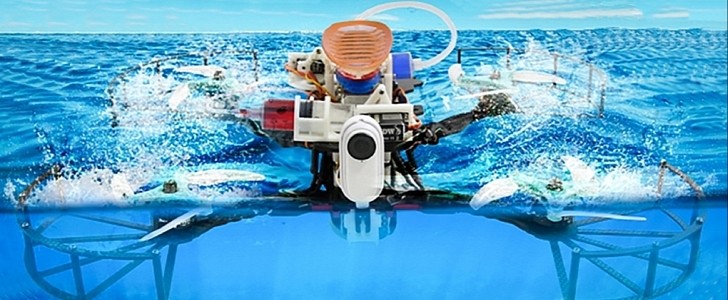As drone development keeps on evolving, UAVs (unmanned aerial vehicles) are no longer limited to operating just in the sky but also underwater, which opens a whole new world of possibilities. Take this promising fish-inspired robot for instance, which can transition from an underwater drone to an aerial vehicle in under one second.
The machine is the creation of a research team of scientists from several institutions: the Imperial College London, Empa, and the Beihang University. Designed as a waterproof quadcopter, the robotic vehicle can dive into the water, hitchhike on wet or dry moving objects to reduce power consumption, and attach itself to any surface. And unlike most aerial-aquatic robots, it can make the switch from underwater to aerial drone in less than a second. The fast transition from water to air is possible thanks to its propellers.
This versatile, 3D-printed robot features a suction pad that is inspired by remora fish, which are renowned for their adhesive discs that allow them to attach themselves to other marine creatures (such as whales or sharks) to move around. The disc is controlled remotely and allows the robot to stick to wet or dry surfaces of different textures. For instance, underwater, it can attach itself to a submarine or any other swimming host vehicles, thus consuming up to 19 times less power than it would if it were to use its self-propulsion.
Its bioinspired adhesive disc also lets it attach to ceilings or any other surfaces, with the drone adapting itself depending on the environment.
As for the potential applications of the fish-inspired drone, this water/air vehicle could have a variety of uses. It could help with marine biological research, surveying ocean pollution in the open sea, it could perform cross-medium retrieval operations in both freshwater and saltwater, it could record video during its air to water transitions, and more.
For now, researchers are still working on further developing this technology.
This versatile, 3D-printed robot features a suction pad that is inspired by remora fish, which are renowned for their adhesive discs that allow them to attach themselves to other marine creatures (such as whales or sharks) to move around. The disc is controlled remotely and allows the robot to stick to wet or dry surfaces of different textures. For instance, underwater, it can attach itself to a submarine or any other swimming host vehicles, thus consuming up to 19 times less power than it would if it were to use its self-propulsion.
Its bioinspired adhesive disc also lets it attach to ceilings or any other surfaces, with the drone adapting itself depending on the environment.
As for the potential applications of the fish-inspired drone, this water/air vehicle could have a variety of uses. It could help with marine biological research, surveying ocean pollution in the open sea, it could perform cross-medium retrieval operations in both freshwater and saltwater, it could record video during its air to water transitions, and more.
For now, researchers are still working on further developing this technology.







